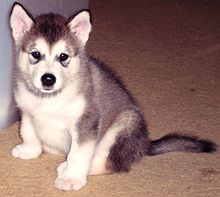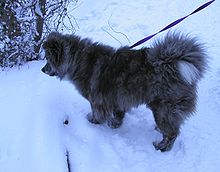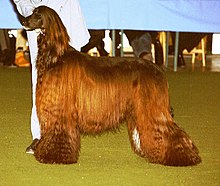Akita
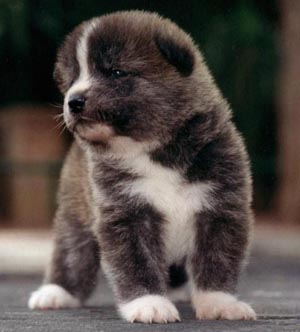
Akita
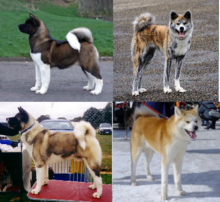 |
| American style Akitas (left) and Japanese style Akitas (right) |
| Other names |
Akita Inu, Japanese Akita, American Akita, Great Japanese Dog (Obsolete) |
| Country of origin |
Japan |
| [hide]Traits |
| Weight |
Male |
American:100–145 pounds (45–66 kg); |
|
Female |
American:80–120 pounds (36–54 kg); |
| Height |
Male |
Japanese: 64-70 cm (25 ¼-27 ½ in); American:26–28 inches (66–71 cm); |
|
Female |
Japanese: 58-64 cm (22 ¾-25 ¼ in); American:24–26 inches (61–66 cm) |
| Coat |
double coat |
| Color |
American: All colours; Japanese: Red, fawn, sesame,
brindle, pure white, all with whitish coat on the sides of the muzzle,
on the cheeks, on the underside of jaw, neck, chest, body and tail and
on the inside of the legs (Urajiro) |
| Litter size |
3–12 puppies, avg. 7–8 |
| Life span |
10 years[1] |
|
| [show]Classification and standards |
|
| Dog (Canis lupus familiaris) |
The
Akita (秋田犬 Akita-inu?) is a large
spitz breed of dog originating from the mountainous northern regions of
Japan. There are now two separate strains:
Japanese, a/k/a "Akita Inu" or "Japanese Akita", and
American,
a/k/a "Akita" or "American Akita". The Japanese strain comes in
selected colors only, with all other colors considered atypical of the
breed, while the American strain comes in all dog colors. The Akita has a
short double
coat, similar to that of many other northern
Spitz breeds,
e.g.,
Siberian Husky,
but long coated dogs can be found in many litters due to a recessive
gene. The American strain of Akita is now considered a separate breed
from the Japanese Akita in many countries around the world, with the
notable exceptions of Australia, the United States and Canada. In the
U.S. and Canada, both strains are considered a single breed with
differences in type rather than two separate breeds. During a short
period, the American strain of Akita was known in some countries as the
"Great Japanese Dog". Both forms of Akita are probably best known
worldwide from the true story of
Hachikō, a loyal Akita dog who lived in Japan before
World War II.
The Akita is a strong, independent and dominant breed, commonly aloof
with strangers but affectionate with family members. They are known to
compete in many dog competition sports, yet some are known to be
intolerant of other dogs and require a knowledgeable and firm handler.
[citation needed]
As a breed, Akitas are generally hardy, but they have been known to
suffer from various genetic conditions and be sensitive to certain
drugs.
Breed name and related issues: American Akita, Akita or Akita Inu
Debate remains among Akita fanciers of both types whether there are, or should be, two distinct breeds of Akita. To date, the
American Kennel Club (AKC),
[2] Canadian Kennel Club (CKC) and
Australian National Kennel Council (ANKC),
[3]
guided by their national breed clubs, consider American and Japanese
style Akitas to be two types of the same breed, allowing free breeding
between the two. The
Federation Cynologique Internationale (FCI),
[4] The Kennel Club (KC),
[5][6] New Zealand Kennel Club (NZKC)
[7][8] and Kennel Clubs of some other nations, including Japan, consider Japanese and American style Akitas as separate breeds.
[9]
However all except the FCI refer to the American style Akita as simply
the "Akita" and not American Akita. Indeed, the issue is especially
controversial in Japan.
[10]
Formally, for the FCI, the breed split occurred June 1999, when the FCI
decided that the American type would be called the Great Japanese Dog,
[9] and this was changed in January 2006 to American Akita.
[9]
History
Japanese history
Japanese history, both verbal and written, describe the ancestors of the Akita, the
Matagi dog (
Japanese:
マタギ犬)(
hunting dog,
Bear hunting dog,
Deer hunting dog),
[11]
as one of the oldest of the native dogs. Today's Akita developed
primarily from dogs in the northernmost region of the island of
Honshū in the
Akita prefecture, thus providing the breed's name.
[11] The Matagi's quarry included
wild boar,
Sika deer, and
Asian black bear.
This swift, agile, unswervingly tenacious precursor dog tracked large
game, holding it at bay until hunters arrived to make the kill. The
breed is also influenced by crosses with larger breeds from Asia and
Europe, including
English Mastiffs,
Great Danes[11] and the
Tosa Inu, in the desire to develop a fighting dog for the burgeoning
dog fighting industry in
Odate, Akita Prefecture, Japan in the early 20th century. During
World War II the Akita was also crossed with
German Shepherd Dogs in an attempt to save them from the war time government order for all non-military dogs to be culled.
[11]
The ancestors of the American style Akita were originally a variety of
the Japanese style Akita, a form that was not desired in Japan due to
the markings, and which is not eligible for show competition.
[9]
Three events focused positive attention on the breed in the early
1900s and brought the breed to the attention of the Western world.
First was the story of
Hachikō, one of the most revered Akitas of all time. He was born in 1923 and owned by Professor
Hidesaburō Ueno of Tokyo.
[12] Professor Ueno lived near the
Shibuya Train Station
in a suburb of the city and commuted to work every day on the train.
Hachikō accompanied his master to and from the station each day.
[13]
On May 25, 1925, when the dog was 18 months old, he waited for his
master's arrival on the four o'clock train. But he waited in vain;
Professor Ueno had suffered a fatal
stroke
at work. Hachikō continued to wait for his master's return. He traveled
to and from the station each day for the next nine years. He allowed
the professor's relatives to care for him, but he never gave up the
vigil at the station for his master. His vigil became world renowned
when, in 1934,
[14] shortly before his death, a
bronze statue was erected at the Shibuya train station in his honor.
[13] This statue was melted down for
munitions during the war and new one commissioned once the war ended.
[14]
Each year on April 8 since 1936, Hachikō's devotion has been honored
with a solemn ceremony of remembrance at Tokyo's Shibuya railroad
station.
[15][16]
Eventually, Hachikō's legendary faithfulness became a national symbol
of loyalty, particularly to the person and institution of the Emperor.
[17]
The second major event was in 1931, when the Akita was officially declared a
Japanese Natural Monument. The Mayor of
Odate City in
Akita Prefecture organized the Akita Inu Hozankai to preserve the original Akita as a Japanese natural treasure through careful breeding.
[13]
In 1934 the first Japanese breed standard for the Akita Inu was listed,
following the breeds declaration as a natural monument of Japan.
[18]
In 1967, commemorating the 50th anniversary of the founding of the
Akita Dog Preservation Society, the Akita Dog Museum was built to house
information, documents and photos.
[13]
The third positive event was the arrival of
Helen Keller
in Japan in 1937. She expressed a keen interest in the breed and was
presented with the first two Akitas to enter the US. The first dog,
presented to her by Mr. Ogasawara and named Kamikaze-go, died at five
months of age from Distemper, one month after her return to the States. A
second Akita was arranged to be sent to Miss Keller, he was Kamikaze's
litter brother, Kenzan-go.
[19] Kenzan-go died in the mid-1940s.
[20] Picture of Helen Keller with Akita. By 1939 a
breed standard had been established and
dog shows had been held, but such activities stopped after
World War II began. Keller wrote in the
Akita Journal:
| “ |
If
ever there was an angel in fur, it was Kamikaze. I know I shall never
feel quite the same tenderness for any other pet. The Akita dog has all
the qualities that appeal to me — he is gentle, companionable and
trusty.[21][22] |
” |
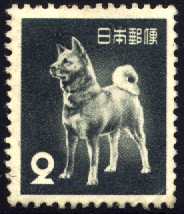
The Akita "Tachibana",
[23] one of the few Akitas to survive the war, pictured here on a Japanese 1953 issue postage stamp
Just as this breed was stabilizing in its native land, World War II
pushed the Akita to the brink of extinction. Early in the war the dogs
suffered from lack of nutritious food. Then many were killed to be eaten
by the starving populace, and their
pelts
were used as clothing. Finally, the government ordered all remaining
dogs to be killed on sight to prevent the spread of disease. The only
way concerned owners could save their beloved Akitas was to turn them
loose in remote mountain areas, where they bred back with their ancestor
dogs, the Matagi,
[11]
or conceal them from authorities by means of crossing with German
Shepherd dogs, and naming them in the style of German Shepherd dogs of
the time.
[11] Morie Sawataishi and his efforts to breed the Akita is a major reason we know this breed today.
[24]
During the occupation years following the war, the breed began to thrive again through the efforts of Sawataishi and others.
[23]
For the first time, Akitas were bred for a standardized appearance.
Akita fanciers in Japan began gathering and exhibiting the remaining
Akitas and producing litters in order to restore the breed to
sustainable numbers and to accentuate the original characteristics of
the breed muddied by crosses to other breeds.
[25] U.S. servicemen fell in love with the Akita and imported many with them upon their return.
American history

9 week old American Akita

4 month old American style Akita pup
The Japanese style Akita and American style Akita began to diverge in
type during the Post–World War II era. It was during this time, that US
servicemen serving as part of the occupation force in Japan first came
into contact with the Akita, the breed so impressed them that many
soldiers chose to bring an Akita back home with them upon completion of
their tour. American soldiers were typically more impressed with the
larger more bear-like fighting Akita or German Shepherd type than they
were with the smaller framed and fox-like Akita-Inu; the types of dogs
they brought back with them to the US reflected this sentiment. Japanese
style Akita fanciers focused on restoring the breed as a work of
Japanese art or to 'Natural Monument' status. American style Akita
fanciers chose to breed larger, heavier-boned and more intimidating
dogs. Although, both types derive from a common ancestry, there are
marked differences between the two. First, while American style Akitas
are acceptable in all colors, Japanese style Akitas are only permitted
to be red, fawn, sesame, white, or brindle. Additionally, American style
Akitas may be pinto and/or have
black masks,
unlike Japanese style Akitas where it is considered a disqualification
and not permitted in the breed standards. American style Akitas
generally are heavier boned and larger, with a more bear-like head,
whereas Japanese style Akitas tend to be lighter and more finely
featured with a fox-like head.
[9]
Recognized by the
American Kennel Club
in 1955, it was placed in the Miscellaneous class. It wasn't until the
end of 1972 that the AKC approved the Akita standard and it was moved to
the Working dog class, as such, the Akita is a rather new breed in the
United States.
Foundation stock in America continued to be imported from Japan until
1974 when the AKC cut off registration to any further Japanese imports
until 1992 when it recognized the Japanese Kennel Club. As previously
stated the majority of Akitas imported Post World War II reflected the
American preference toward the German Shepherd or Fighting Dog type
Akita. The decision by the AKC to disallow the registration of any
further imported dogs in 1974, set the stage for the divergence in type
between the American Akita and Japanese Akita Inu that is present today
by making the Fighting Dog type the foundation stock of the American
Akita.
Elsewhere in the world, the American style Akita was first introduced
to the UK in 1937, he was a Canadian import, owned by a Mrs. Jenson,
however the breed was not widely known until the early 1980s.
[20] The breed was introduced in Australia in 1982 with an American Import and to New Zealand in 1986 with an import from the U.K.
[20]
Description

American style Akita female
Appearance
As a northern breed (generically, Spitz), the appearance of the Akita
reflects cold weather adaptations essential to their original function.
The Akita is a substantial breed for its height with heavy bones.
Characteristic physical traits of the breed include a large, bear-like
head with erect, triangular ears set at a slight angle following the
arch of the neck. Additionally, the eyes of the Akita are small, dark,
deeply set and triangular in shape.
[26]
Akitas have thick double coats, and tight, well knuckled cat-like feet.
Their tails are carried over the top of the back in a graceful sweep
down the loin, into a gentle curl, or into a double curl.
[27]
Mature American type males measure typically 26-28 inches (66–71 cm)
at the withers and weigh between 100-130 lb (45–59 kg). Mature females
typically measure 24-26 inches (61–66 cm) and weigh between 70-100 lb
(32–45 kg).
[28] The Japanese type, as stated in the breed standards, are a little smaller and lighter.
Breed standards state that all dog breed coat colors are allowable in
the American style Akita, including pinto, all types of brindle, solid
white, black mask, white mask, self colored mask, even differing colors
of under coat and overlay (guard hairs).
[29] This includes the common
Shiba Inu
coloring pattern known as Urajiro. The Japanese style Akitas, as per
the breed standards, are restricted to red, fawn, sesame, brindle, pure
white, all with "Urajiro" markings
i.e., whitish coat on the
sides of the muzzle, on the cheeks, on the underside of jaw, neck,
chest, body and tail and on the inside of the legs.
[5]
Coat types
There are two coat types in the Akita, the standard coat length and
the long coat. The long coat is considered a fault in the show ring,
however, they still make good pets.
[30] The long coat, also known as 'Moku' is the result of a
autosomal recessive gene and may only occur
phenotypically if both sire and dam are carriers. They have longer (about 3-4 inches in length) and softer coats
[31] and are known to have sweeter temperaments.
[30] It is believed that this gene comes from the now extinct
Karafuto-Ken 樺太犬 (
extirpated in Japan, anyway) Dog of Russia.
[32]
Temperament
The Akita today is a unique combination of dignity, courage,
alertness, and devotion to its family. It is extraordinarily
affectionate and loyal with family and friends, territorial about its
property, and can be reserved with strangers. It is feline in its
actions; it is not unusual for an Akita to clean its face after eating,
to preen its kennel mate, and to be fastidious in the house.
[33] They are however known to be intolerant of other dogs of the same gender, as stated in the AKC breed standard.
[2]
Since it is a large, powerful dog, the Akita is not considered a
breed for a first time dog owner. The breed has been targeted by some
countries'
breed-specific legislation as a dangerous dog.
[34][35][36][37]
The Akita is a large, strong, independent and dominant dog. A dog with
the correct Akita temperament should be accepting of non-threatening
strangers, yet protective of their family when faced with a threatening
situation. They should be docile, aloof and calm in new situations. As a
breed they should be good with children, it is said that the breed has
an affinity with children, just as retrievers have an affinity with
sticks and balls.
[38]
However all care and caution should be taken with children and large
dogs. Not all Akitas, nor all dogs, will necessarily have a correct
temperament.
[39]
The Akita was never bred to live or work in groups like many hound
and sporting breeds. Instead, they lived and worked alone or in pairs, a
preference reflected today. Akitas tend to take a socially dominant
role with other dogs, and thus caution must be used in situations when
Akitas are likely to be around other dogs, especially unfamiliar ones.
In particular, Akitas tend to be less tolerant of dogs of the same sex.
For this reason, Akitas, unless highly socialized, are not generally
well-suited for off-leash
dog parks.
[33]
The Akita is docile, intelligent, courageous and fearless, careful and
very affectionate with its family. Sometimes spontaneous, it needs a
firm, confident, consistent pack leader, without which the dog will be
very willful and may become very aggressive to other dogs and animals.
[39]
Health
The health conditions mentioned below are by no means only specific to the Akita, but also to many other breeds including
mix or cross breeds.
[40] All however, have been seen enough in the Akita to be listed as conditions known to occur in the breed as per citations.






